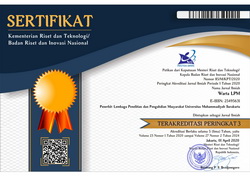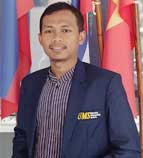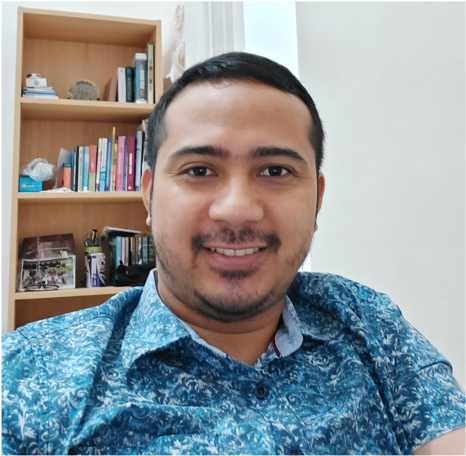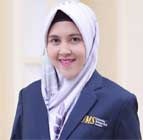Pemantauan Status Kesehatan dengan Memanfaatkan Aplikasi Z-Health Guna Meningkatkan Perilaku Pencegahan Penyakit Tidak Menular Pada Posyandu Remaja di Desa Mliwis Cepogo Boyolali
DOI:
https://doi.org/10.23917/warta.v27i1.3126Keywords:
Posyandu remaja, Aplikasi, pencegahan penyakit tidak menular (PTM)Abstract
The program partner for this community service student creativity program is the youth posyandu in Tambakboyo Hamlet, Mliwis Village, Cepogo, Boyolali. The problem faced by partners is that health screening results are not given after the posyandu activities end so that teenagers do not remember their health history and teenagers do not make efforts to prevent health problems. Apart from that, youth posyandu activities still require a variety of counseling topics as well as effective and innovative delivery methods. The aim of this community service program is to solve the problems faced by partners health monitoring using the Z-Health application. The methods for implementing the PKM program include observation and survey of the needs of youth posyandu, preparation of educational materials, training on how to use the application and peer counseling for cadres, training on using the Z-Health application for teenagers, as well as assisting youth posyandu using the Z-Health application. The results achieved from this community service program are that through the Z-Health application, teenagers can monitor their health status, receive health education and receive counseling. With this, there is an increase in behavior to prevent non-communicable diseases with CERDIK behavior. There is also an increase in understanding regarding non-communicable diseases (NCDs) and an increase in knowledge of peer counseling for posyandu cadres.
Downloads
References
Afritia, M., Zen Rahfiludin, M., Puskesmas Melayu Kota Piring, D., & Kesehatan Kota Tanjung Pinang, D. (2019). Peran Posyandu Remaja Terhadap Perilaku Kesehatan Reproduksi Remaja Di Kota Tanjungpinang.
Akbar, H., & Budi Santoso, E. (2020). Analisis Faktor Penyebab Terjadinya Hipertensi Pada Masyarakat. In Universitas Muhammadiyah Palu MPPKI (Vol. 3, Issue 1).
Ali, A., Nurcholida, A., Rangki, L., Kedokteran Universitas, F., Oleo, H., Provinsi, K., & Tenggara, S. (2021). Nomor 2 Oktober. 3, 7–16.
Andini, O. P., Dominicha, Ernalem. T., Emelia. Agustina, Laura, O. K., & Muhammad, S. H. (2022). Pos Pemkes Hipertensi (Pos Pemeriksaan Kesehatan Hipertensi) Dan Edukasi Hipertensi Di Wilayah Rt.003 Rw.003 Kelurahan Guntung Paikat, Kecamatan Banjarbaru Selatan, Kota Banjarbaru, Kalimantan Selatan.
Badrul, M. (2021). Penerapan Metode Waterfall Untuk Perancangan Sistem Informasi Inventory Pada Toko Keramik Bintang Terang. 8(2).
Ema, W., Dewi, P., Nurul, A., & Dwi, A. (2022). Pengembangan Program Posyandu Remaja Dusun Jipangan, Bangunjiwo, Kasihan, Bantul, Yogyakarta.
Farkhah, L. (2021). Hubungan Tingkat Pengetahuan Dan Sikap Remaja Terhadap Perilaku Merokok. Jurnal Keperawatan Muhammadiyah Bengkulu, 9(2), 32–37. https://doi.org/10.36085/jkmb.v9i2.1992
Fatkhullah, M. (2023). Tingkat Kepuasan Kelompok Masyarakat Alam Tani Terhadap Program Csr Pt Kilang Pertamina Internasional Unit Dumai. https://doi.org/10.29103/jsds.v%vi%i.10278
Junengsih, Y. (2017). Hubungan Asupan Zat Besi Dengan Kejadian Anemia Pada Remaja Putri Smu 98 Di Jakarta Timur.
Kusnadi, F. N. (2021). Hubungan Tingkat Pengetahuan Tentang Anemia Dengan Kejadian Anemia Pada Remaja Putri. http://jurnalmedikahutama.com
Kustandi, C., Farhan, M., Zianadezdha, A., Fitri, A. K., & L, N. A. (2021). Pemanfaatan Media Visual Dalam Tercapainya Tujuan Pembelajaran. Akademika, 10(02), 291–299. https://doi.org/10.34005/akademika.v10i02.1402
Putri Anisha. (2017). Efektifitas Media Audio Visual Dan Leaflet Terhadap Peningkatan Pengetahuan, Sikap.
Riset Kesehatan Dasar (2018). Kementrian Kesehatan Republik Indonesia
Rahmawaty, S., Ni, A., Azizah, mah, & Maliha Sofwah, U. (2022). Konsultasi Gizi untuk Meningkatkan Pengetahuan Siswa Sekolah Menegah Atas tentang Gizi Seimbang. Jurnal Warta LPM, 25. http://journals.ums.ac.id/index.php/warta
Ridzkyanto, R. P. (2020). Gambaran Strata Posyandu di Kecamatan Mumbulsari Kabupaten Jember. Jurnal Penelitian Kesehatan “SUARA FORIKES” (Journal of Health Research “Forikes Voice”), 11, 57. https://doi.org/10.33846/sf11nk209
Rival, H. (2017). Penerapan Teknologi Informasi Digital Library Ur Dengan Menggunakan Technology Acceptance Model Di Fisip Universitas Riau. In JOM FISIP (Vol. 4, Issue 2).
Salmiati, S., Rosmawati, R., & Lestari, M. (2018). Peer Counselor Training Untuk Mencengah Perilaku Bullying. Indonesian Journal of Learning Education and Counseling, 1(1), 62–69. https://doi.org/10.31960/ijolec.v1i1.37
Setia Sandi, A. A., Soedijono, B., & Nasiri, A. (2022). Use Of Tam For Evaluation Of Internship Information System. Technology Acceptance Model) Jurnal TAM, 13(1). https://ojs.stmikpringsewu.ac.id/index.php/JurnalTam/index
Siswanto, Y., & Afandi, A. (2019). Peningkatan Pengetahuan Tentang Hipertensi Pada Remaja. Jurnal Pemberdayaan Masyarakat Mandiri Indonesia, 2(3).
Siswati, S. (2020). Identifikasi Penderita Hipertensi untuk Melakukan Pengobatan secara Teratur Melalui Konseling. INVOTEK: Jurnal Inovasi Vokasional Dan Teknologi, 20(2), 67–74. https://doi.org/10.24036/invotek.v20i2.700
Supadi, J., Mintarsih, S. N., & Ambarwati, R. (2023). Efektivitas Konselor Sebaya dalam Peningkatan Pengetahuan dan Sikap tentang Gizi Seimbang pada Remaja Overweight. Jurnal Ilmiah Gizi Dan Kesehatan (JIGK), 4(02), 1–6.
Wahyuni, S., Dosen Prodi, N. S., & Ilmu Kesehatan IIK Bhakti Wiyata Kediri, F. (2016). Pengaruh Edukasi Hipertensi Dengan Media Booklet Terhadap Perilaku Self Management Pada Pasien Hipertensi Di Wilayah Puskesmas Balowerti Kediri. Jurnal Ilmu Kesehatan, 5(1).
Zis, S. F., Effendi, N., & Roem, E. R. (2021). Perubahan Perilaku Komunikasi Generasi Milenial dan Generasi Z di Era Digital. Satwika : Kajian Ilmu Budaya Dan Perubahan Sosial, 5(1), 69–87. https://doi.org/10.22219/satwika.v5i1.15550
Downloads
Submitted
Accepted
Published
How to Cite
Issue
Section
License
Copyright (c) 2024 Warta LPM

This work is licensed under a Creative Commons Attribution 4.0 International License.















